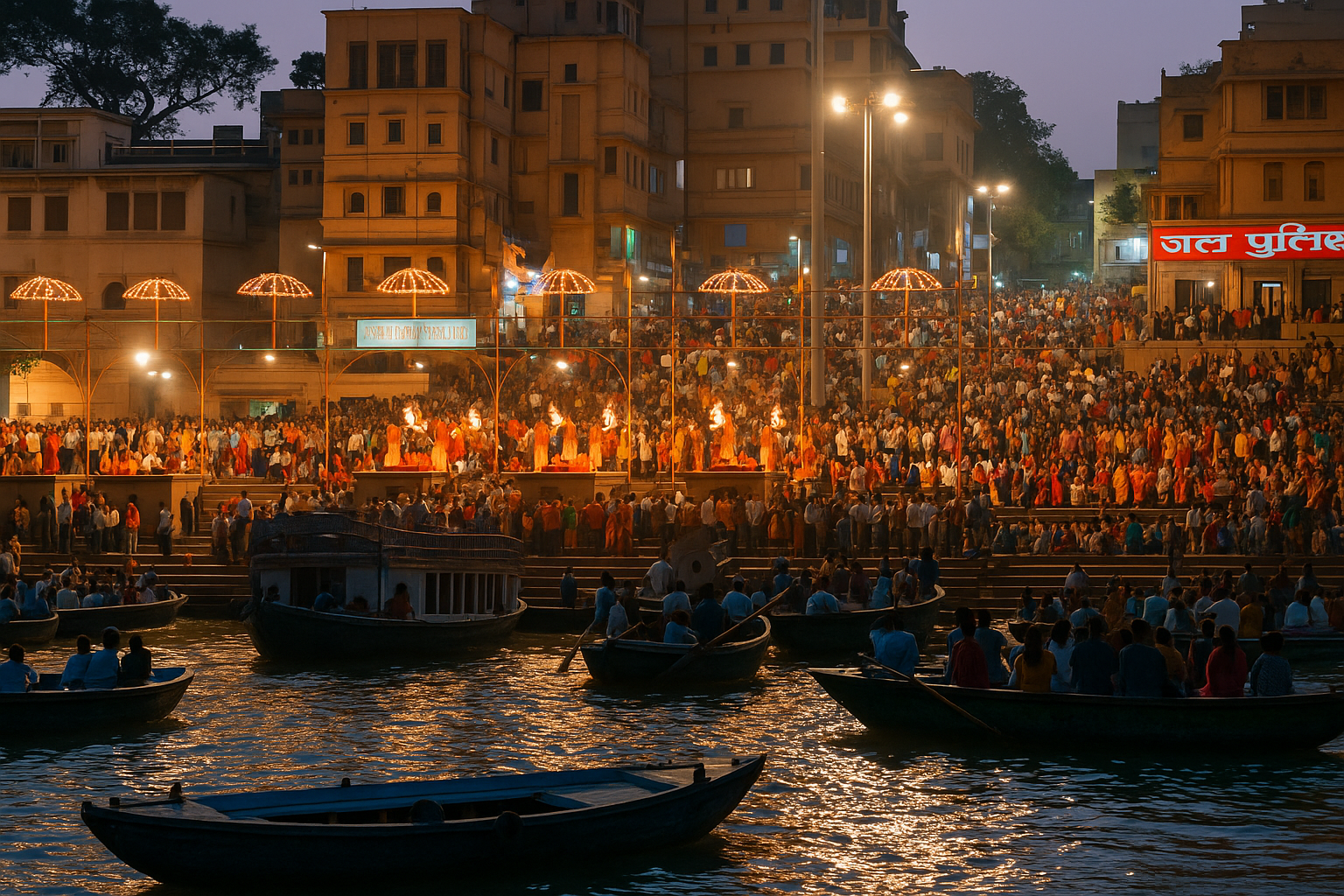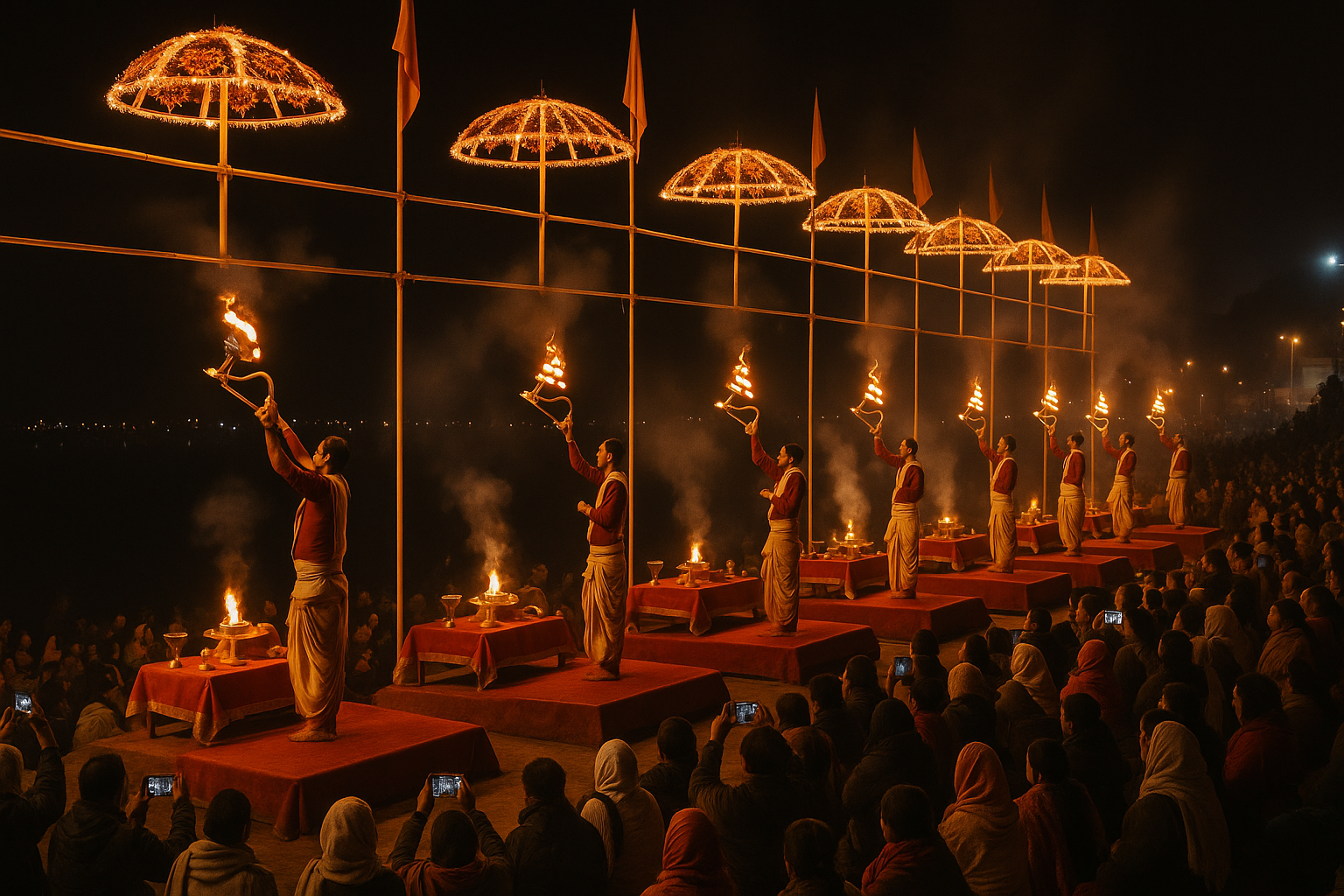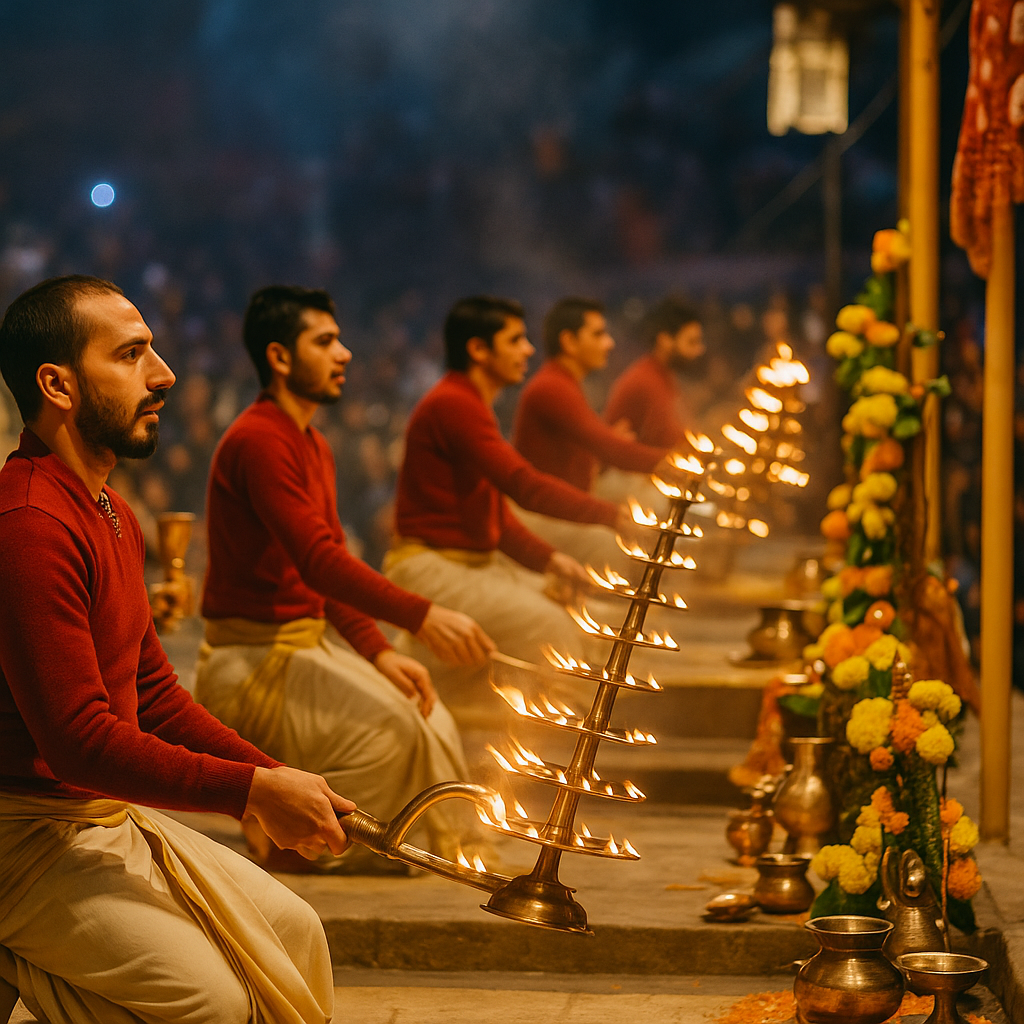“Where fire meets faith and rhythm meets river — Ganga Aarti is Kashi’s sacred heartbeat.”
What is Ganga Aarti?
The Ganga Aarti is a powerful spiritual ritual held daily on the banks of the sacred Ganga River in Varanasi. Performed at sunset, it is a way to honor Mother Ganga, believed to cleanse sins and bless all who worship her. The aarti involves flames, chanting, incense, music, and deep reverence—creating an unforgettable atmosphere of devotion.
In recent years, it has become one of the largest daily spiritual gatherings in India, drawing hundreds of thousands of pilgrims and travelers alike. Its primary locations in Varanasi are:
- Dashashwamedh Ghat
- Rajendra Prasad Ghat (adjacent to Dashashwamedh)
- Assi Ghat (Evening Aarti, in addition to morning rituals)
History & Mythological Roots
The Aarti ritual finds its origin in Vedic fire worship, but the mythology tied to it is equally significant. Legend says Goddess Ganga descended from the heavens in response to King Bhagiratha’s prayers to cleanse the sins of his ancestors. To soften her celestial descent, Lord Shiva caught her in his locks, releasing her gently to the earth. The Ganga Aarti honors this divine story every evening through sound, fire, and movement.
The modern Ganga Aarti ritual at Dashashwamedh Ghat began in 1991, spearheaded by the Gangotri Seva Samiti. Today, it is a synchronized spiritual performance that continues daily, uninterrupted, through rain, winter, and festivals.
Ritual Steps and Symbolism
Seven priests conduct the Aarti with highly synchronized choreography, wearing saffron-white robes, and using:
- Conch Shells – mark the beginning, inviting purity
- Incense – purifies the surroundings
- Brass Lamps (Deepams) – symbolize fire and divine light
- Peacock and Yak-tail Fans – represent air and space
- Flowers – signify earth and devotion
- Water and Diyas – reflect the flow and illumination of life
Each action mirrors the five cosmic elements (Pancha Mahabhutas) and is meant to invoke universal harmony.
Ganga Aarti Timings in Varanasi
| Aarti Type | Location | Winter Timing | Summer Timing | Notes |
| Evening Aarti | Dashashwamedh Ghat | 6:00 PM | 7:00 PM | Grandest ceremony. Arrive early for best spots. |
| Evening Aarti | Rajendra Prasad Ghat | 6:00 PM | 7:00 PM | Extension of Dashashwamedh. Less crowded. |
| Evening Aarti | Assi Ghat | 6:30 PM approx | 7:30 PM approx | Now a full-scale evening event, also draws large crowds. |
| Morning Aarti | Assi Ghat (Subah-e-Banaras) | 6:00 AM | 5:00 AM | Includes yoga, bhajans, and sunrise prayers. |
| Morning Aarti | Panchganga Ghat | 5:30 AM | 5:30 AM | Intimate and peaceful, esp. during Kartik month. |
Where is Ganga Aarti Performed?
While Dashashwamedh Ghat is the iconic location, you can also experience the evening Aarti at:
- Rajendra Prasad Ghat: A natural extension of the main ritual with slightly fewer crowds.
- Assi Ghat: Previously known for Subah-e-Banaras (morning program), Assi Ghat now also hosts a well-attended evening Aarti with full rituals, musicians, and a large following.
For those seeking a quieter, personal experience, smaller ghats like Panchganga, Kedar, Shivala, and Harishchandra Ghat also offer Aartis conducted by individual priests.
How to Attend the Ganga Aarti: Options & Recommendations
1. From the Ghats (On Foot)
- Best for Immersive Devotion
- Arrive 45–60 minutes early and find a seat on the white chairs or platforms.
- Platforms closest to the priests give the best up-close view (not all are reserved).
- Ideal for photographers, spiritual seekers, or those who want to feel the vibration of the ritual from within the crowd.
VIP Rooftop Seating by Ganga Seva Samiti
- The best elevated view of the Aarti from the rooftop of the Gangotri Seva Samiti office.
- Seating is limited, reserved, and paid. Advance booking is essential.
- Offers a clear, unobstructed perspective—ideal for guests who want to observe the ritual peacefully without the crowd.
- Often bundled with Ganga Poojan, and funds support the organization of the Aarti.
Tip: You can book Ganga Poojan + VIP seats directly through Ganga Seva Samiti’s trusted representatives.
2. From a Boat (Shared or Private)
- Panoramic View of the Aarti
- Boats line up in the river facing the ghat. You can hire them on-site or pre-book.
- Shared boats are affordable but may be crowded.
- Private boats offer better positioning, quiet, and exclusivity.
- Great for those who want to photograph the event against the glowing ghats or prefer not to be in a dense crowd.
3. From a Ganga Cruise
- Premium Experience with Comfort
- Modern cruise boats offer cushioned seats, upper decks, and guided explanations.
- Perfect for families, elders, or those seeking comfort without sacrificing the view.
- Cruises often include 84-ghat tours before reaching Dashashwamedh Ghat for the Aarti finale.
- Must be pre-booked, especially during festivals or Dev Deepawali.
Photography Tips
- Use fast shutter speed (1/100 or faster) for motion.
- Keep flash OFF. It disrupts ambiance and others’ experiences.
- Best angle: Priests in the center are often most polished in movement.
- Shoot with the river in the background to avoid ghat lighting.
Etiquette During Aarti
- Dress modestly; this is a sacred ritual.
- Refrain from pushing, standing in front of others, or talking loudly.
- Photography is allowed, but do not block others’ views or walk around mid-ritual.
Conclusion: A Moment That Stays With You Forever
The Ganga Aarti in Varanasi is not merely a religious practice—it is a living river of devotion, performed every single day for decades without fail. Whether from the ghats, the boats, or the cruise decks, witnessing this sacred flame ceremony is to touch the soul of Kashi itself.
In the hush of the crowd, in the roar of the conch, in the dance of the flame—you find yourself swept away by the same timeless current that has flowed through Banaras for millennia.
Maps
Video
FAQ's
Where does the Ganga Aarti take place in Varanasi?
The main Ganga Aarti takes place at Dashashwamedh Ghat, but it is also performed at Rajendra Prasad Ghat (adjacent to Dashashwamedh) and Assi Ghat in the evening. Morning Aartis are held at Assi Ghat (Subah-e-Banaras) and Panchganga Ghat.
What time does the Ganga Aarti start?
Evening Aarti: Winter: 6:00 PM Summer: 7:00 PM Morning Aarti: Assi Ghat: 6:00 AM (Winter), 5:00 AM (Summer) Panchganga Ghat: 5:30 AM (year-round) Arrive at least 45–60 minutes early to secure a good spot.
Is there any entry fee to attend the Ganga Aarti?
No, attending the Aarti is free for all. However, VIP seating and Ganga Poojan rituals can be reserved for a fee through Ganga Seva Samiti or local organisers.
Can I watch the Ganga Aarti from a boat?
Yes. Watching from a boat or Ganga cruise offers a beautiful panoramic view. Boats can be shared or private and should be booked in advance, especially during festivals or peak seasons.
What is the difference between the Ganga Aarti at Dashashwamedh and Assi Ghat?
Dashashwamedh Ghat hosts the grandest and most iconic Aarti. Assi Ghat’s evening Aarti has grown significantly in scale and crowd size, while its morning Subah-e-Banaras program includes yoga, live music, and meditation.
Is photography allowed during the Ganga Aarti?
Yes, but be respectful. Flash photography is discouraged, and it’s important not to block others’ views or disrupt the ceremony. Serious photographers prefer tripods and high ISO settings without flash.
What is the VIP seating and how do I book it?
Ganga Seva Samiti offers VIP seats on their rooftop, providing the best elevated view of the Aarti at Dashashwamedh Ghat. These must be booked in advance, often alongside a Ganga Poojan ritual. Booking is done via their official desk or trusted representatives at the ghat.
Is Ganga Aarti held during monsoon or bad weather?
Yes. The Ganga Aarti is held every evening without fail, regardless of weather conditions—even in rain or winter.
Can I participate in the ritual?
Yes. You can join the Ganga Poojan, a pre-Aarti offering ritual with diyas and flowers, often guided by a priest. Booking this also helps support the Seva Samiti and may include VIP seating.




